#us national air and space museum
Text
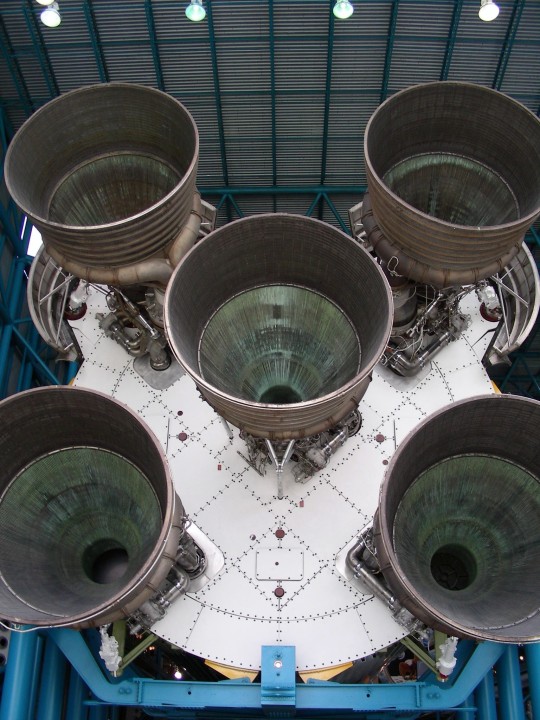
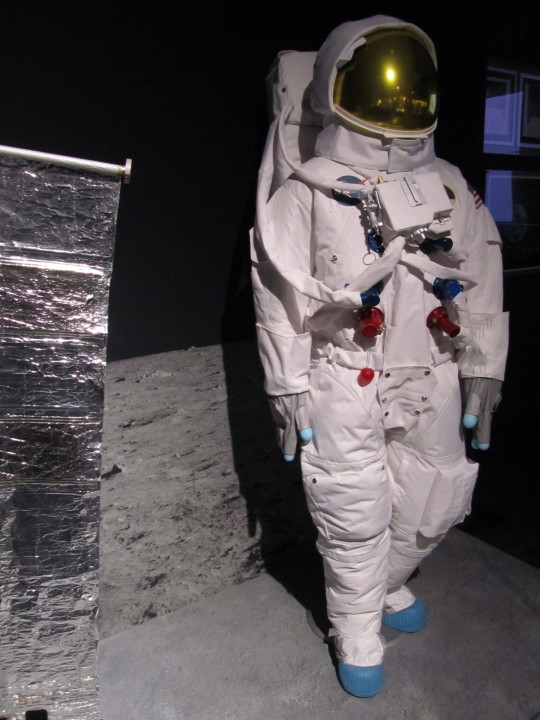
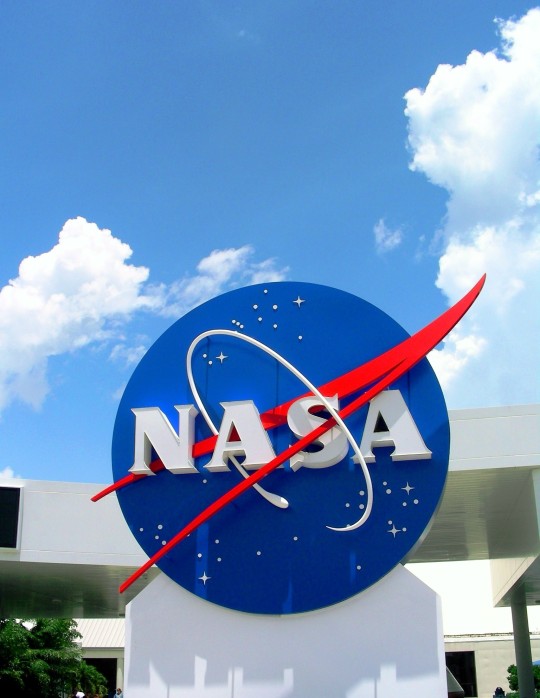
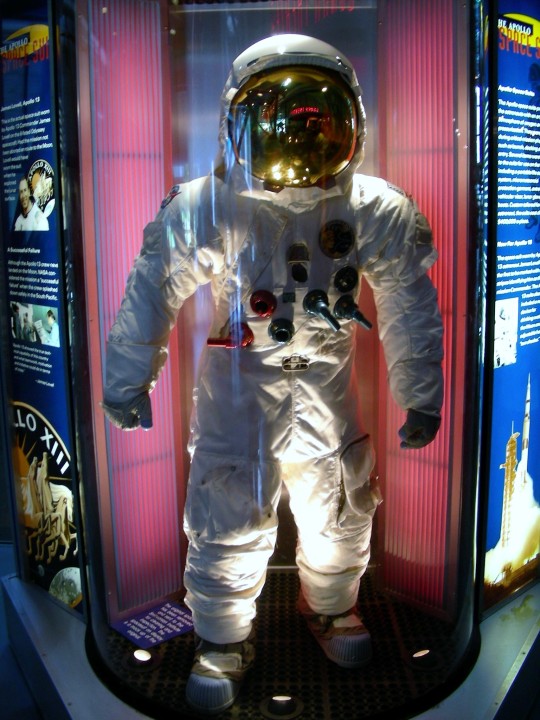
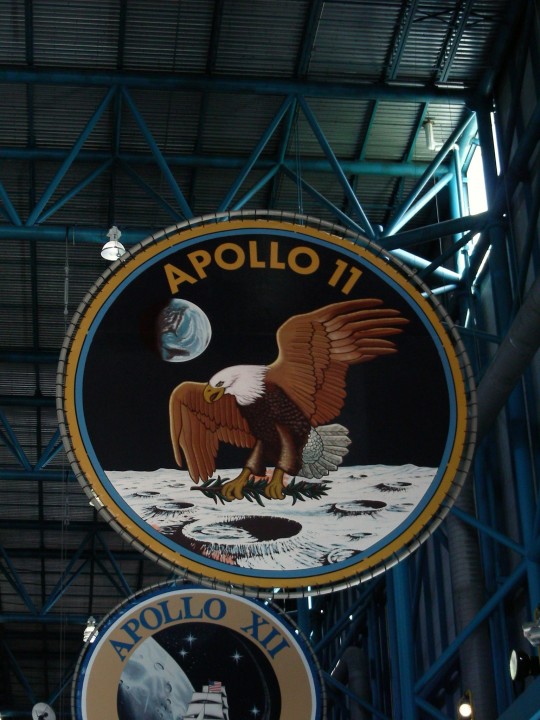
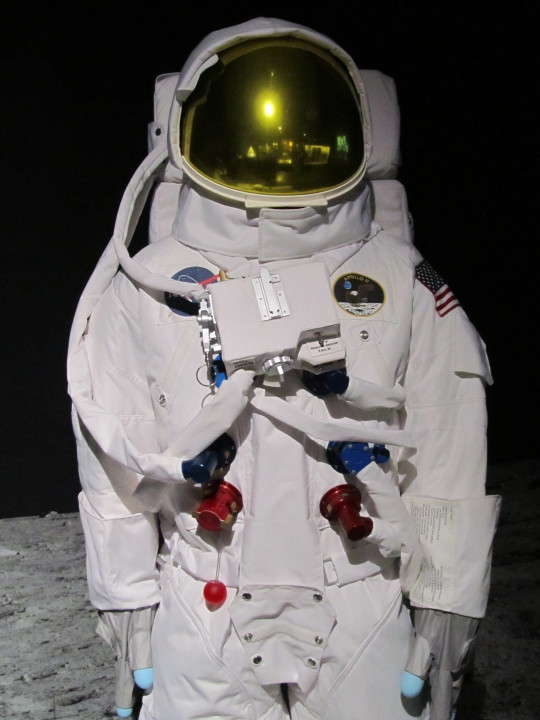
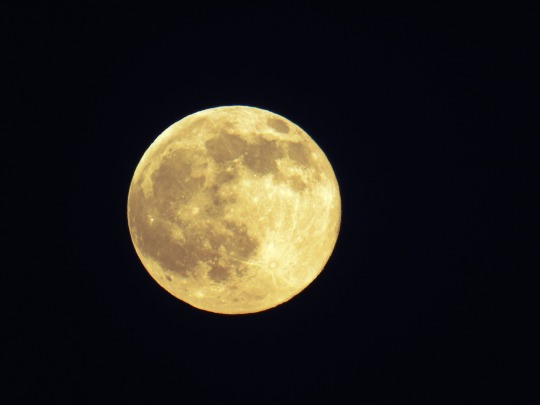


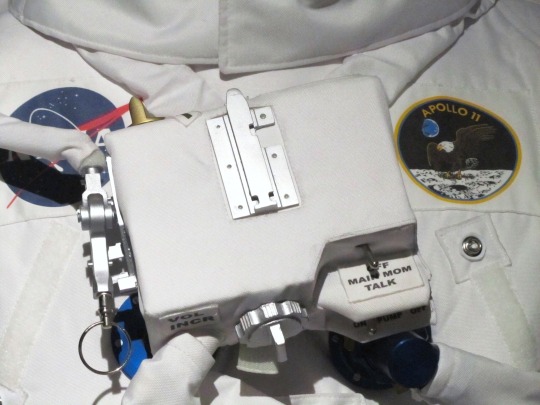
Apollo program: Apollo 11’s crew successfully makes the first manned landing on the Moon in the Sea of Tranquility. Americans Neil Armstrong and Buzz Aldrin became the first humans to walk on the Moon (July 21 UTC) on July 20, 1969.
#Apollo 11#first manned landing#moon#20 July 1969#21 July 1969 UTC#Kennedy Space Center Visitor Complex#Saturn V#NASA#National Aeronautics and Space Administration#Launch Complex 39A (LC-39)#Florida#USA#Verkehrshaus der Schweiz#Swiss Transport Museum#Apollo 11 Command Module 'Columbia'#National Air and Space Museum#replica#space suit#original photography#travel#vacation#tourist attraction#55th anniversary#US history
9 notes
·
View notes
Text


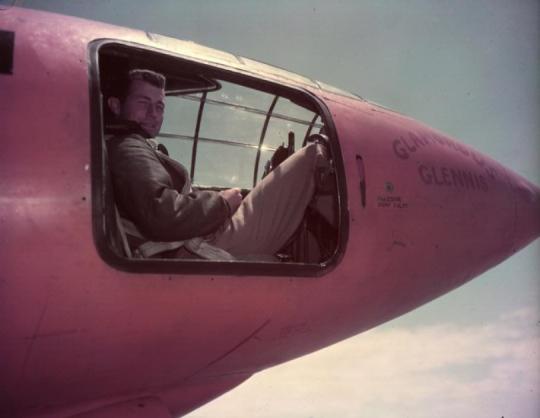

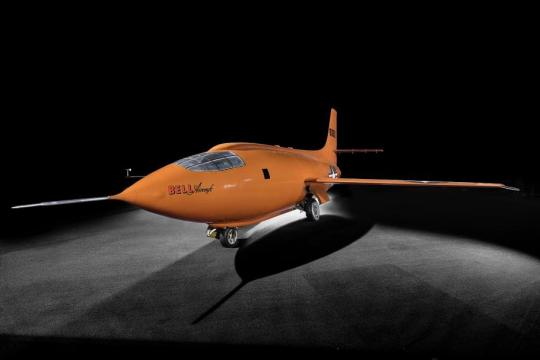
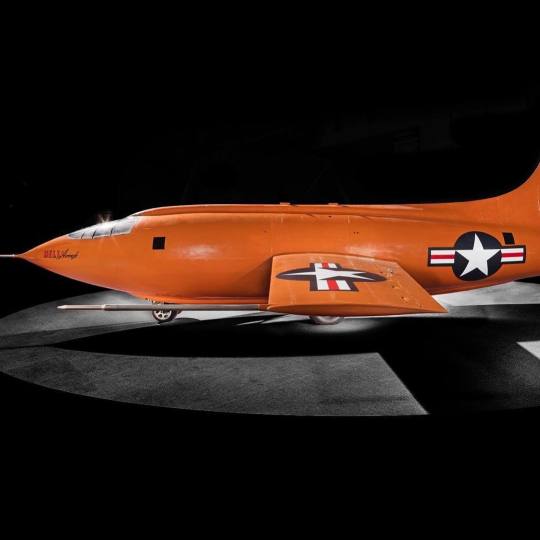
"The real barrier wasn't in the sky but in our knowledge and experience of supersonic flight."
Seventy-five years ago, on October 14, 1947, Chuck Yeager proved it was possible to fly faster than the speed of sound in the Bell X-1 "Glamorous Glennis,” reaching Mach 1.06. The Bell X-1 was the first in a series of supersonic aircraft which continue to push the boundaries of what's possible in aviation. That very Bell X-1 is on display at the Udvar-Hazy Center at the Smithsonian's National Air and Space Museum in Washington DC and includes a signature from Yeager and the date of the record-breaking flight.
Breaking the Sound Barrier: Chuck Yeager and the Bell X-1
#otd#chuck yeager#aviation#aviation history#glamorous glennis#bell x-1#history#us history#The Smithsonian#smithsonian#national air and space museum
1 note
·
View note
Text
The summer before our trio's senior year, there's a national competition for high-schoolers. The prize? An all-expenses-paid trip to Washington, D.C., including exclusive tours of the Smithsonian and a face-to-face meeting with the President.
This is the chance they need to escape the prison that the GIW has turned Amity Park into and get them shut down, permanently.
Tucker rigs it.
Danny is out to the class by now. Lancer is keeping his mouth shut. He's a mandatory reporter, sure, but he won't speak up and put his student in more danger.
Danny is very, very happy about the visit to the Air and Space museum.
Then it's time for business.
First, the confession: they weren't the rightful winners.
Then, the introduction: they're not just a class trip.
They're the diplomatic envoy of Phantom, the High King of the Infinite Realms of the Dead. And by diplomacy or by force, the American government will stop torturing and experimenting on his subjects.
Everyone in Amity Park is forsworn by the US government as long as the Anti-Ecto acts are in force; they're all contaminated enough that the GIW has the right to snatch them up and cut them open.
They're all voluntarily Danny's subjects instead. He, at least, has no need for taxes.
#danny phantom#prompt#uhhh this might be a bit jumbled up#its late and i'm tired#but i think the general idea gets through
462 notes
·
View notes
Text

The Rift - Chapter One
Pairing: Marcus Moreno x Marcus Acacius x Marcus Pike x f!Reader
Rating: Chapter is T, overall fic is E (18+ only, explicit smut)
Word Count: 1.5k
Warnings: Unrequited crushes, yearning, questionable science
Summary: Two weeks after the Rift appears, Marcus Pike and the Art Crimes team have been inundated by black market artifacts, and Marcus is more than happy to use this as an excuse to get closer to the curator who is helping them identify the items. Meanwhile, the perpetrators enlist a supervillain to cause a blackout around the Rift in order to steal even more. Hopefully that doesn't cause anything bad to happen!
A/N: We're building toward something big! One thing that I am doing in this fic, for my sanity and for yours, is identify the POV character whenever it changes. I don't usually do this, preferring to rely on narrative, but when three of your characters share the same name, this gets complicated.
Masterlist | Prologue | Next Chapter>>
(Pike)
Marcus Pike takes the steps to the National Gallery of Art two at a time. At the top, he catches his reflection in one of the large font windows and pauses to attempt to flatten his windswept hair before dashing through the revolving doors. He flashes a smile–and his badge–at the security guard, who recognizes him and nods. Rather than funnel through the ticketing counter with the rest of the guests, Marcus instead ducks through a door labeled ‘MUSEUM STAFF ONLY,’ hops down the stairs–three at a time, this time–and opens another door to the curation department, making a beeline for the now-familiar office.
“I’ve got another one for you,” he announces breathlessly, forgetting to knock.
The occupant startles, sending a novelty coffee mug full of pens and highlighters scattering across the floor.
“Marcus,” you hiss, pressing one hand over your pounding heart. “Oh my God, you can’t keep doing that!”
“Sorry,” he grimaces. “I, uh, guess I got a little excited.”
“Two thousand year-old artifacts will do that to a man, I guess.” You take in his heaving chest, askew tie, and mussed hair. “Did you… run here?”
Marcus feels heat flush to his cheeks, and he grins sheepishly. Oh, if only he could say that it’s
not just the startlingly well-preserved bronze comb now sitting in the evidence locker right next to the carefully cataloged Roman coins, ceramic glazed urn, ceremonial dagger, and a scroll of papyrus, all in pristine condition. No, it’s not just the flood of bizarre artifacts suddenly entering the black market that has Marcus’s heart pumping with excitement.
It’s the far-too-cute-for-her-own-good Museum Curator at the National Gallery of Art that has been indispensable in these cases, identifying and verifying the authenticity of each new artifact recovered by him and his team.
“Like you said, ancient artifacts really get the blood flowing,” Marcus grins, daring to chance a wink in your direction. “I dunno if you can really call them ‘artifacts,’ though. Or even ‘ancient.’ Weird times we’re in, right now.”
His thoughts drift to the Rift again–common knowledge, not just in DC but throughout the entire globe now, still less than a month into its existence. Heavily guarded, of course, and entrance is strictly prohibited. Hell, even loitering in the vicinity of the Rift earned Marcus a stern telling-off that even his FBI credentials couldn’t override. He couldn’t get the sight of it out of his mind, though. It was as though the empty space around the Rift simply… broke. Like the universe as he knew it was, and then suddenly was not in the space of around ten feet wide. He tried to look through the hole, through the bit that ‘was not,’ but it was like looking through warped glass. The air itself bent and swirled, and through it he swore he could hear the sound of hooves on cobblestone, snippets of language he had read his fair share of in graduate school but had never heard spoken aloud.
“So you uh… want me to come take a look?” you ask, sounding almost shy.
“I thought you’d never ask.”
“I’m not running, though, so don’t even try.”
Marcus laughs joyfully. He can’t seem to stop smiling whenever he’s lucky enough to be in your presence, and of late, that means he’s smiling a lot.
“Walking sounds perfect,” he agrees. “Plus, that was enough cardio for me for the whole week, I think.”
You grin back, and Marcus wonders if you can feel the electricity that seems to descend whenever the two of you banter, or if it’s only him that’s affected. Sounds about right, he muses ruefully to himself. You old sap. Still, the silence stretches out just a beat too long, and it sends his imagination whirling. Coffee dates, long walks through the city, cozy drinks on his sofa oh shit how do you even ask someone out in the age of Tinder–
“Lead the way, Agent,” you smirk, and Marcus feels himself melt.

You click your tongue thoughtfully as you examine the comb. “Bronze, Imperial, I’m gonna guess somewhere around… 500 BCE?”
Marcus whistles through his teeth, impressed. “How do you know that?”
You pick up one of the coins. “Numismatics. Anyone with a working knowledge of Roman history can place one of these babies within a few decades or so.” You flip it over, revealing the stark profile of the Emperor. “This was around the height of his rule and he died in 504 BCE. Knowing that, the coins are from around 510-ish, so everything else that comes out of the Rift, well…”
“You think all of it’s from around the same time,” Marcus offers.
You shrug. “They’re all coming from the same hole in space and time.”
“What I don’t understand,” Marcus mumbles, more to himself than to you, “is how the hell people are getting in and out of the damn thing, it’s so heavily guarded.”
“I’ll say,” you comment wistfully. “They’ve got that whole perimeter set up now, you can’t go within a quarter of a mile. Wish I could see it… I mean, talk about a curator’s dream, right?”
“It’s incredible,” he says softly.
“Wait. You’ve seen it? How?”
Marcus smiles and holds out his hands, feeling slightly guilty. “Managed to hoodwink a few people with my credentials, but I barely got within eyesight before I was politely asked to leave.”
“By politely, I’m assuming you mean ‘with an assault rifle.’”
“Maybe a little.”
“Okay, now I’m pissed at you. And don’t flash those big brown puppy dog eyes at me,” you snap, right as Marcus begins to do exactly that. “Throwing your FBI Agent weight around, and you couldn’t even bring along your consultant.”
“Oh yeah, because I really wanted to put you at the end of some Heroic bigwig’s assault rifle as well,” Marcus laughs. “It was stupid, I let curiosity get the better of me. What can I say?”
“You can say you’re sorry by buying me a coffee. Not the swill they’ve got here, a proper latte. And while I drink it nice and slow-like, you have to tell me everything.”
Marcus can’t think of a single better way to spend the rest of his afternoon.

Electricity crackled at his fingertips. Even if the paycheck hadn’t been enough to convince him, the ultimate test of his powers was enough for him to agree to something so petty as theft. For that’s what it was, when you took away all the other factors. The Rift was simply a complication. A variable.
A challenge.
Giving things power had always been his strong suit. Taking it away was another thing entirely, like flexing an unfamiliar muscle, or wiggling your ears. His biggest undertaking before now had been to shut down electricity to one wing of a building, but a whole city block?
Intriguing.
Lurking in the shadows, at a safe distance from any of the Heroics security, the man known only as Voltage flared his nostrils, drawing the electricity back up into his body, and then… he pulled. Extracting the electrons from the world around him, his fingers flexed and strained as the current flowed backward, like forcing a waterfall to run in reverse. All the lights within a four block radius from the Rift–from cars, streetlights, personal flashlights, mobile phones, and screens–cracked and popped ominously before shattering and bathing the entire area in darkness.

(Pike)
Not two miles away, the fluorescent light above Marcus Pike flickers, the unpleasant sound of electricity causing the hairs to rise on the back of his neck. Pulling a face, he rubs at the sore muscle with one hand, sits back in the uncomfortable metal chairs of the evidence room, and yawns loudly.
“What I find interesting is that there doesn’t seem to be any residue on any of the items,” his partner remarks, seemingly ignoring the yawn.
“What kind of residue?” Marcus asks, curious.
“I dunno, like… time residue?”
The Agent laughs good-naturedly. “Time residue, huh? What the hell is that?”
“Haven’t you ever seen any SciFi movies?”
Marcus shoots the other Agent a skeptical look. “Last time I checked, this wasn’t a movie.”
“Exactly. So we have no idea what kind of thing we’re dealing with. I mean, come on. Black hole guns? Holes in space-time? And you’re drawing the line at residue?”
Marcus laughs again, shutting his laptop with a sigh. “Jesus, I had no idea how late it had gotten. Let’s take a break and start again in the morning, yeah?”
“D’you think anything else has come out of the Rift?” his partner suddenly asks.
“Other than the artifacts they’re smuggling? Dunno,” Marcus answers. “They’ve got that place locked down pretty tight. I’ve been wondering how the hell they’ve been getting this stuff out of there,” he remarks, repeating what he had said to you earlier that day.
“If a bunch of coins are able to get out, it’s only a matter of time before… other stuff does, too.”
Marcus pauses, one hand reaching toward the door. The statement troubles him more than he cares to admit.
“Above my pay grade,” he tries to joke, but it doesn’t land. “Those Heroics guys have to have a handle on things.”

113 notes
·
View notes
Text
50 Years Ago: Apollo 17
Not long after midnight on Dec. 7, 1972, the last crewed mission to the Moon, Apollo 17, lifted off with three astronauts: Eugene Cernan, Harrison Schmitt, and Ronald Evans.
Experience the Apollo 17 launch and follow the mission in real time.
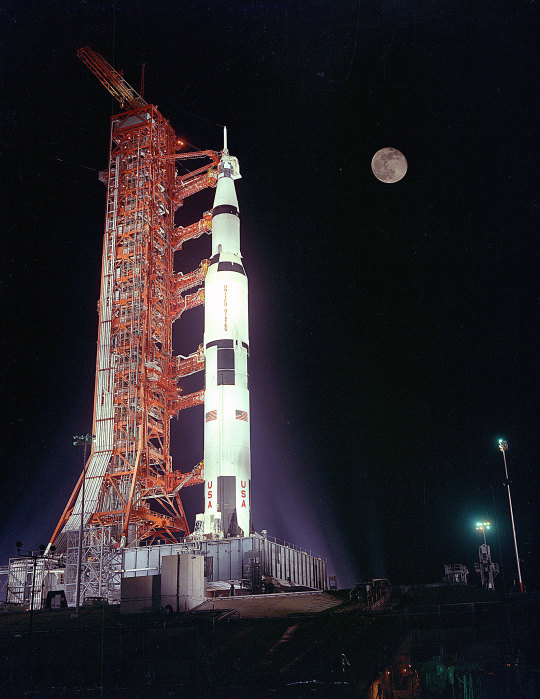
Meet the Crew
Let’s meet the astronauts who made the final Apollo trip to the Moon, including the first scientist-astronaut.
Gene Cernan: In 1972, Apollo 17 Mission Commander Eugene A. Cernan had two space flights under his belt, Gemini 9 in June 1966, and Apollo 10 in May 1969. He was a naval aviator, electrical and aeronautical engineer and fighter pilot.
Ron Evans: Apollo 17 Command Module Pilot Ronald E. Evans was selected as a member of the 4th group of NASA astronauts in 1966. Like Cernan, he was an electrical and aeronautical engineer, and naval aviator before his assignment to the Apollo 17 crew.
Harrison (Jack) Schmitt: Lunar Module Pilot Dr. Harrison (Jack) Schmitt joined NASA as a member of the first group of scientist-astronauts in 1965. Before working for NASA, Schmitt was a geologist at the USGS Astrogeology Center. He was on the backup crew for Apollo 15 before being selected for the prime crew of Apollo 17. He became the first of the scientist-astronauts to go to space and the 12th human to walk on the Moon.
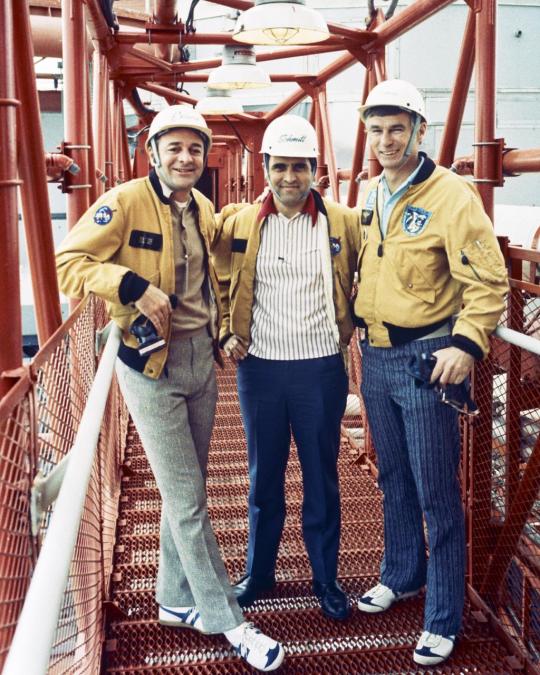
The Blue Marble
“The Blue Marble,” one of the most reproduced images in history, was taken 50 years ago on Dec. 7, 1972 by the Apollo 17 crew as they made their way to the Moon.

Bag of Soup, Anyone?
NASA astronauts have an array of menu items to stay well fed and hydrated on missions. For Apollo 17, the menus allocated around 2,500 calories per day for each astronaut. They included:
Bacon Squares
Peanut Butter Sandwiches
Frankfurters
Lobster Bisque
Like anything going to space, weight and containment matter. That's why the Apollo 17 menu included plenty of soups and puddings.
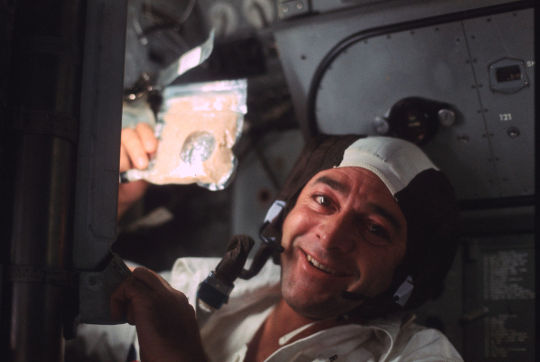
Synchronicity
On Dec. 11, 2022, the Artemis I mission will be splashing down on Earth after its 25.5-day mission. At 2:55 p.m. 50 years prior, the Apollo 17 lunar module (LM) landed on the Moon, with Commander Gene Cernan and LM Pilot Harrison Schmitt on board. Ron Evans remained in the Command and Service Module (CSM) orbiting the Moon.
Experience the landing.
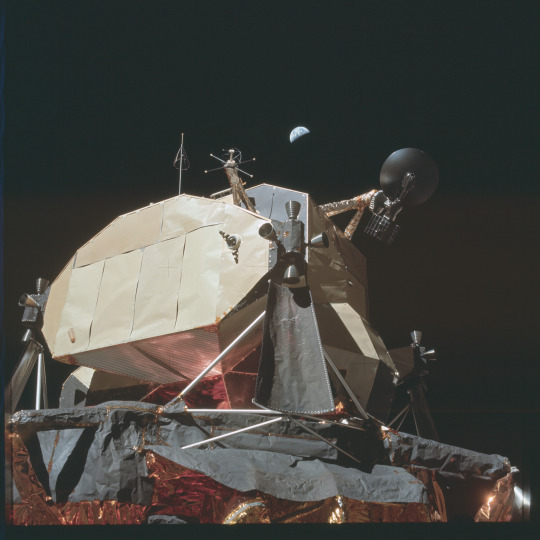
Planting the Flag
One of the first tasks the Apollo 17 crew did on their first moonwalk was to plant the American flag. There’s no wind on the Moon, but that doesn’t mean the flag has to droop. Did you know that a horizontal rod with a latch makes the flag appear to be flying in the wind? Gene Cernan carefully composed this photo to get Schmitt, the flag, and the Earth in a single shot.
So, is the flag still there? Images of the Apollo 17 landing site from the Lunar Reconnaissance Orbiter Camera show that in 2011 the flag was still standing and casting a shadow!
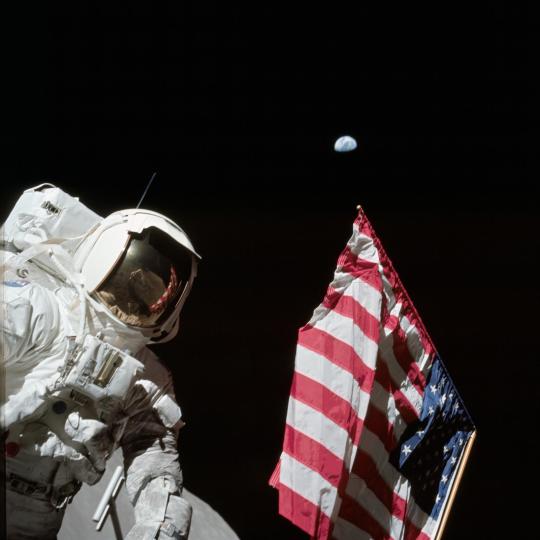
Moon Buggy
During Apollo 17, the Lunar Rover Vehicle (LRV), nicknamed the Moon buggy, logged the farthest distance from the Lunar Module of any Apollo mission, about 4.7 miles (7.5 km).
As a precaution, the LRV had a walk-back limit in the event of an issue; astronauts had to have enough resources to walk back to the lunar module if need be.
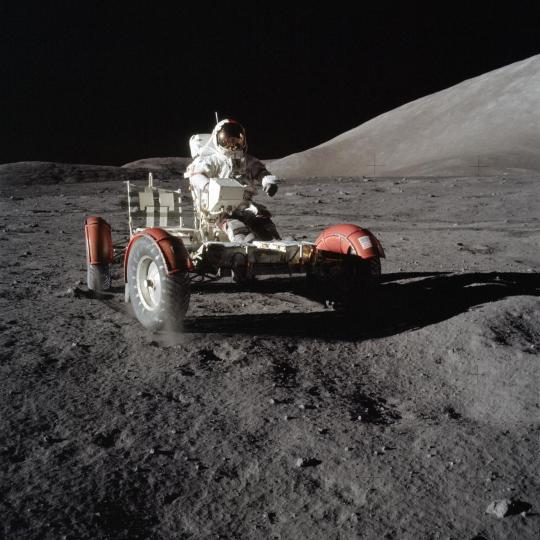
Grab the Duct Tape!
The right rear fender extension of the LRV (Moon buggy) was torn off, kicking up dust as the crew drove, reducing visibility. The crew made a resourceful repair using duct tape and maps.
For LRV fans, visiting an LRV driven on the Moon is a bit difficult since all three LRVs used on the Apollo 15, 16, and 17 missions were left on the Moon. But you can find an LRV used for training at the National Air and Space Museum in Washington.
Read more about the LRV.

The Perils of Lunar Dust
After the first lunar EVA, Apollo 17 astronaut Harrison Schmitt reported that he suffered from “lunar hay fever” in reaction to the lunar dust. Unlike Earth’s dust particles which are rounded, Moon dust particles are sharp and abrasive, irritating astronaut eyes, nasal passages, and lungs.
Curious about how Moon dust feels and smells? Find out!

So What’s it Like?
After his return to Earth, Apollo 17 astronaut Harrison Schmitt (on the right) described his time on the Moon:
“Working on the Moon is a lot of fun. It’s like walking around on a giant trampoline all the time and you’re just as strong as you were here on Earth, but you don’t weigh as much.”

Splashdown!
After 12 days and 14 hours in space, the Apollo 17 astronauts splashed down in the Pacific Ocean at 2:25 p.m. EST on Dec. 19, 1972. It was the longest of all the Apollo missions, with the most photos taken. A recovery team was waiting on the USS Ticonderoga just 4 miles (6.4 km) away to pick up the astronauts, the lunar samples, and the Crew Module.
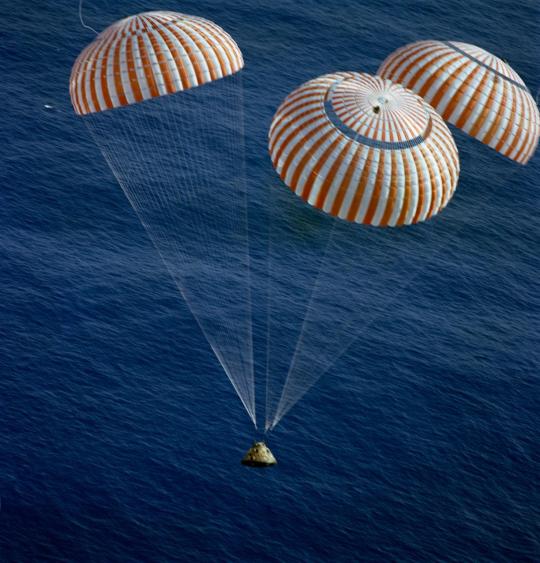
When Are We Going Back?
NASA’s Artemis Program has taken its first steps to sending humans back to the Moon with Artemis I, currently on its way back to Earth. The program plans to land humans, including the first women and person of color, on the Moon’s south polar region with its Artemis III mission, currently slated to launch in 2025.
Is aerospace history your cup of tea? Be sure to check out more from NASA’s past missions at www.nasa.gov/history.
Make sure to follow us on Tumblr for your regular dose of space!
2K notes
·
View notes
Video
X-15 Launch from B-52 Mothership by NASA on The Commons
Via Flickr:
This photo illustrates how the X-15 rocket-powered aircraft was taken aloft under the wing of a B-52. Because of the large fuel consumption, the X-15 was air launched from a B-52 aircraft at 45,000 ft and a speed of about 500 mph. This was one of the early powered flights using a pair of XLR-11 engines (until the XLR-99 became available). The X-15 was a rocket-powered aircraft 50 ft long with a wingspan of 22 ft. It was a missile-shaped vehicle with an unusual wedge-shaped vertical tail, thin stubby wings, and unique fairings that extended along the side of the fuselage. The X-15 weighed about 14,000 lb empty and approximately 34,000 lb at launch. The XLR-99 rocket engine, manufactured by Thiokol Chemical Corp., was pilot controlled and was capable of developing 57,000 lb of rated thrust (actual thrust reportedly climbed to 60,000 lb). North American Aviation built three X-15 aircraft for the program. The X-15 research aircraft was developed to provide in-flight information and data on aerodynamics, structures, flight controls, and the physiological aspects of high-speed, high-altitude flight. A follow-on program used the aircraft as a testbed to carry various scientific experiments beyond the Earth's atmosphere on a repeated basis. For flight in the dense air of the usable atmosphere, the X-15 used conventional aerodynamic controls such as rudder surfaces on the vertical stabilizers to control yaw and canted horizontal surfaces on the tail to control pitch when moving in synchronization or roll when moved differentially. For flight in the thin air outside of the appreciable Earth's atmosphere, the X-15 used a reaction control system. Hydrogen peroxide thrust rockets located on the nose of the aircraft provided pitch and yaw control. Those on the wings provided roll control. Because of the large fuel consumption, the X-15 was air launched from a B-52 aircraft at 45,000 ft and a speed of about 500 mph. Depending on the mission, the rocket engine provided thrust for the first 80 to 120 sec of flight. The remainder of the normal 10 to 11 min. flight was powerless and ended with a 200-mph glide landing. Generally, one of two types of X-15 flight profiles was used: a high-altitude flight plan that called for the pilot to maintain a steep rate of climb, or a speed profile that called for the pilot to push over and maintain a level altitude. The X-15 was flown over a period of nearly 10 years--June 1959 to Oct. 1968--and set the world's unofficial speed and altitude records of 4,520 mph (Mach 6.7) and 354,200 ft (over 67 mi) in a program to investigate all aspects of piloted hypersonic flight. Information gained from the highly successful X-15 program contributed to the development of the Mercury, Gemini, and Apollo manned spaceflight programs, and also the Space Shuttle program. The X-15s made a total of 199 flights and were manufactured by North American Aviation. X-15-1, serial number 56-6670, is now located at the National Air and Space Museum, Washington DC. NASA Media Usage Guidelines Credit: NASA Image Number: E-4942 Date: 1959
31 notes
·
View notes
Text




Where are the SR 71’s today?
They are all on display in America with one exception. #962 is at Duxford, Great Britain. this SR-71 was the one that was the most frequently stationed in Great Britain It’s a permanent loan from the United States to Great Britain with our thanks.
Arizona
#17951 flew on March 5, 1965, and served as a test bird throughout its career. It is currently displayed at the Pima Air Museum, Tucson, AZ.
California
California is home to more SR-71 aircraft than any other state. It houses six of them, listed below:
•SR-71A #17955 - AFFTC Museum, Edwards AFB, CA.
•SR-71A #17960 - Castle Air Museum near Atwater, CA.
•SR-71A #17963 - Beale AFB, CA.
•SR-71A #17973 - Blackbird Airpark, Palmdale, CA.
•SR-71A #17975 - March Field Museum, March AFB, CA.
•SR-71A #17980 - NASA's Dryden Flight Research Center as #844.
Florida
In Florida, specifically at the USAF Armament Museum, Eglin AFB, FL, the SR-71A #61-7959, also known as the "Big Tail," is on display. This nickname dates to 1975, when it was chosen as the platform for a new series of sensors placed in an extension towards the rear of the aircraft . The last flight of this aircraft took place on October 29, 1976
Georgia
At the Museum of Aviation, Robins AFB, GA, the Blackbird SR-71A #17958 is on display. According to various records, on July 28, 1976, this example facilitated a human being (pilot captain Eldon W. Joersz and major RSO George T. Morgan Jr.) to reach the highest speed ever aboard an aircraft.
Kansas
SR-71A #17961 accumulated 1601 flight hours until February 2, 1977, the date of its last flight. It is currently on display between a Northrop T-38 Talon advanced trainer and a life-size replica of the Space Shuttle at the Kansas Cosmosphere and Space Center, Hutchinson, KS
Louisiana
At the 8th Air Force Museum, Barksdale AFB, LA, the SR-71A #17967 is on display, one of two examples reactivated in 1995 for USAF service before the program was canceled in 1998. Over the years, this aircraft accumulated more than 2700 flight hours.
Texas
At the USAF History and Traditions Museum, Lackland AFB, TX, is SR-71A #17979, which was used as a reconnaissance aircraft during Operation Giant Reach in the Egyptian-Israeli war.
Michigan
Two trainer variants were built, denoted SR-71Bs. One crashed on approach to Beale AFB on January 11, 1968, while the other, SR-71B #17956, is displayed at the Kalamazoo Aviation History Museum in Kalamazoo, MI. This SR-71 has more flight hours than any other Blackbird, nearly 4000, and is believed to have been photographed more times than any other.
Nebraska
At the Strategic Air and Space Museum near Ashland, NE, SR-71A #17964 is on display. Its first flight took place in 1966, and the last in 1990, when it was delivered to Offutt AFB, NE, to be permanently exhibited
Ohio
The first operational ( Jerry O’Malley and Ed Payne) mission of an SR-71 was carried out by SR-71A #17976 before concluding its career with about 3000 flight hours. It is among the first SR-71s to be permanently exhibited and best preserved. It is displayed at the National Museum of the United States Air Force, Wright-Patterson AFB, OH.
Oregon
Below the right wing of Howard Hughes' H-4 Hercules at the Evergreen Aviation Museum in McMinnville, OR, is the most complete and accurate SR-71, SR-71A #17971, which has accumulated over 3500 flight hours.
Utah
As mentioned, after January 11, 1968, when half of the SR-71 trainer fleet was lost due to the crash of #17957, a replacement trainer was built, designated SR-71C #17981. This aircraft is currently on display at the Hill Aerospace Museum, Hill AFB, UT. Irregular maintenance procedures and aftermarket construction caused constant yaw of the aircraft; therefore, the SR-71C was used on a limited basis between 1969-1976.
Virginia
The state of Virginia hosts two SR-71s:
•SR-71A #17968 is displayed at the Science Museum in Richmond, VA. 2. The #972 at Udvar-Hazy
Chantilly,
Linda Sheffield
@Habubrats71 via X
#sr71#sr 71#sr 71 blackbird#aircraft#lockheed aviation#skunkworks#usaf#mach3+#habu#reconnaissance#aviation#cold war aircraft
32 notes
·
View notes
Text

Langley Aviation 2-4 prototype (NX 29099) on January 19, 1942.
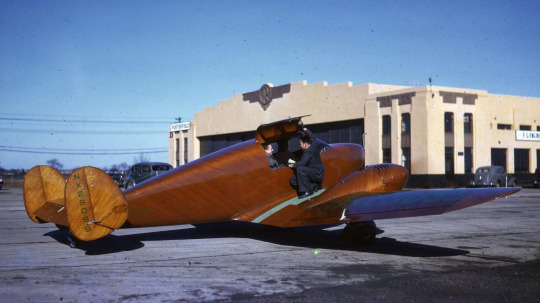
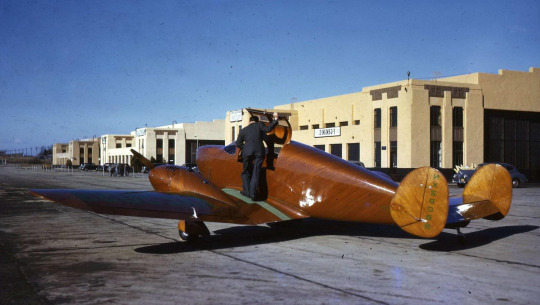
"The first model was the 2-4-65 and flew in 1940. The second model was the 2-4-90 which flew in 1941 and was taken on by the USN as the XNL-1."
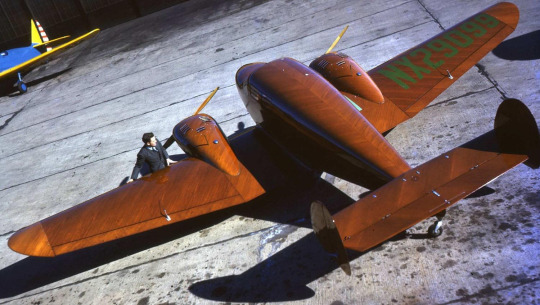
"Built in 1941 from mahogany veneers impregnated with vinyl and phenol to conserve strategic materials. However, when the U.S.A. entered the war the phenol and vinyl used in the manufacturing process were found to be in short supply and so no long term manufacture was made."

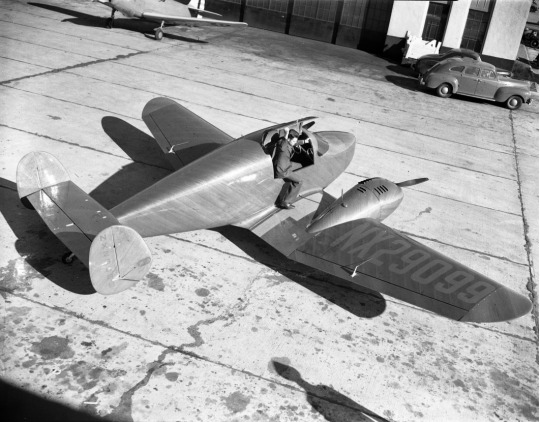


Martin Jensen at the controls
Power plant 2 x 90 h.p Franklin 4AC
Span 35'2" Length 20'8"
Max speed 135 mph Range 400 miles Service ceiling 13,300 ft
Posted on r/WeirdWings by u/jacksmachiningreveng: link
source
Rudy Arnold Photo Collection, Acc. NASM.XXXX.0356, National Air and Space Museum, Smithsonian Institution.
#Langley Aviation 2-4#aircraft#January#1942#World War II#World War 2#WWII#WW2#WWII History#History#Langley XNL-1#XNL-1#United States Navy#U.S. Navy#US Navy#USN#Navy#Langley Monoplane#Langley Twin#Langley 2-4 Twin#2-4#Twin#Langley 2-4#my post
56 notes
·
View notes
Text

Have Researchers Found Amelia Earhart’s Long-Lost Plane?
A new sonar image shows an airplane-shaped object resting on the bottom of the Pacific Ocean, not far from where Earhart and her navigator, Fred Noonan, went missing in 1937.
On July 2, 1937, pioneering pilot Amelia Earhart vanished somewhere over the Pacific Ocean near the end of her historic around-the-world flight. For decades, her mysterious disappearance has perplexed explorers, who have spent millions of dollars trying to find her missing Lockheed 10-E Electra plane.
Now, a possible new clue has emerged in the case: A sonar image captured during an expedition last fall shows an airplane-shaped object sitting on the ocean floor, not far from where experts believe Earhart likely crashed, reports the Wall Street Journal’s Nidhi Subbaraman.
The blurred object is far from definitive proof, but Dorothy Cochrane, an aeronautics curator at the Smithsonian’s National Air and Space Museum, tells Smithsonian magazine it’s “an intriguing image” that warrants a second look.
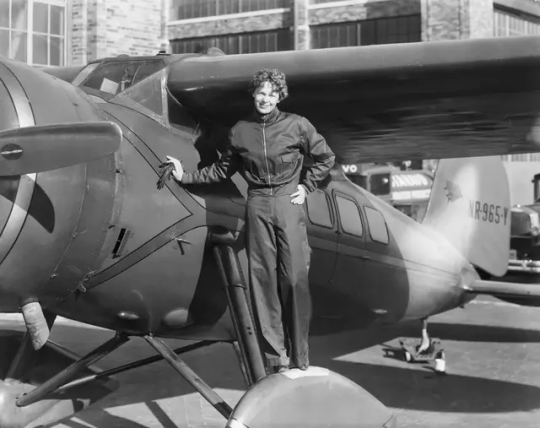

The expedition was led by Tony Romeo, who is a former intelligence officer with the U.S. Air Force, a pilot and a commercial real estate investor from South Carolina. In 2021, he sold his real estate properties and spent $11 million to fund the trip, including buying high-tech equipment to aid in the search.
“This has been a story that’s always intrigued me, and all the things in my life kind of collided at the right moment,” Romeo tells Business Insider’s Katherine Tangalakis-Lippert and Rebecca Rommen. “I was getting out of real estate and looking for a new project, so even though I really started about 18 months ago, this was something I’ve been thinking and researching for a long time.”
Last September, a team from the exploration company Deep Sea Vision, which Romeo founded, departed from Tarawa, Kiribati, in the South Pacific aboard a research vessel. Working in 36-hour shifts, the 16-person crew used an underwater autonomous vehicle equipped with sonar to scour the sea floor, scanning roughly 5,200 total square miles.
About 90 days into the trip, the team was reviewing sonar images and noticed something unusual in the data from some 60 days prior. The mysterious object looked to be about the same shape and size as an aircraft, and it was identified roughly 100 miles from Howland Island, which is within the region where experts think Earhart’s plane went down. The object is around 16,400 feet below the water’s surface.

By then, however, the crew had determined it was too late to return to the site for a closer look. The camera on the underwater vehicle was also broken, which meant they wouldn’t be able to see anything if they did circle back, reports the Post and Courier’s Tony Bartelme.
But Romeo is undeterred and hopes to revisit the area in the future.
“This is maybe the most exciting thing I’ll ever do in my life,” he tells the Wall Street Journal. “I feel like a 10-year-old going on a treasure hunt.”
In the meantime, the sonar image is not detailed enough for experts to draw any definitive conclusions.
“It definitely appears to be an aircraft of some sort,” David Jourdan, who has searched three times for Earhart’s missing plane and is the co-founder and president of the ocean exploration company Nauticos, tells the Post and Courier. “It has aircraft-like features. But sound is funny. It can mislead you. We can’t say it’s her plane until you put a camera on it.”
To truly identify the object, future missions would ideally capture detailed images that contain the registration number of the plane, says Cochrane. Or, at the very least, they might more clearly show the submerged object’s dimensions and shape to see if it matches the model of Earhart’s vehicle.

“It really requires further research,” says Cochrane. “Finding something that’s really worth investigating further is step one. Verifying it’s the actual craft is step two. And step three becomes: Is it possible to recover this or not, or should it just be left where it is?”
At the time of her disappearance, Earhart was a global celebrity—speaking with the Wall Street Journal, Romeo likens her to Taylor Swift today. In June 1928, Earhart became the first woman to fly across the Atlantic Ocean (as a passenger of pilots Wilmer Stultz and Lou Gordon), a feat that propelled her to international stardom.
Nearly four years later, in May 1932, she made history again by becoming the first woman to fly solo across the Atlantic Ocean. Later that year, she became the first woman to fly solo across North America and back. And in 1935, she became the first person, regardless of gender, to fly solo from Honolulu, Hawaii, to Oakland, California.
In the summer of 1936, the renowned pilot began to plan her most ambitious trip yet: a circumnavigation of the globe. On May 20, 1937, Earhart and her navigator, Fred Noonan, departed from Oakland for the first leg of the trip. They flew nearly 22,000 miles, making stops in Miami, South America, Africa and India along their eastward route.
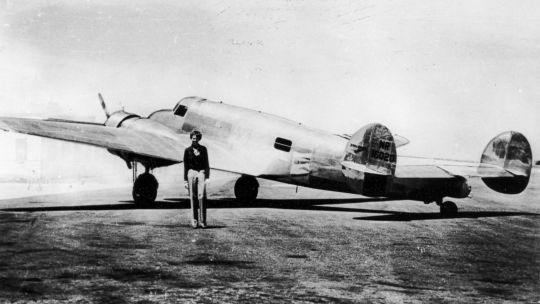
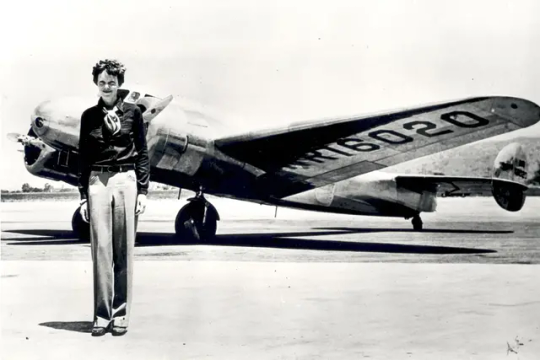
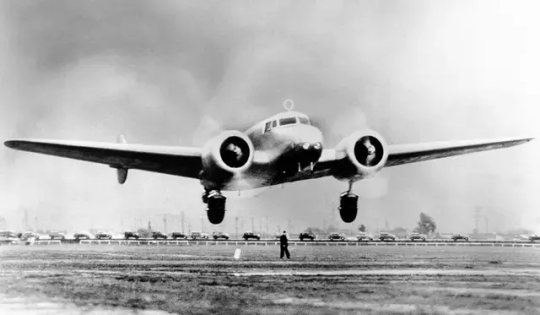
By late June, they had made it to Lae, Papua New Guinea. After a few days’ rest, they departed for Howland Island, a small, uninhabited outcrop in the Pacific where a refueling station had been built for their journey. The U.S. Coast Guard had a vessel, the Itasca, stationed nearby to help with the landing.
Operators aboard the Itasca heard Earhart’s radio messages as she got closer and closer to the island. But eventually, they lost contact. Earhart and Noonan were never seen or heard from again.
The U.S. Navy and Coast Guard spent 16 days searching for the missing duo without success. About one and a half years later, on January 5, 1939, Earhart was declared dead.
Theories abound about her mysterious disappearance—some onlookers have speculated that she was a spy or that she was captured by a foreign military. But Cochrane believes the simplest explanation is the most plausible: that Earhart and Noonan ran out of fuel near Howland Island.
“She’s got to be around there somewhere,” she adds.
By Sarah Kuta.
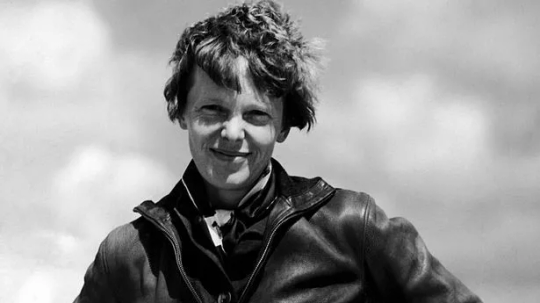
#Amelia Earhart#Have Researchers Found Amelia Earhart’s Long-Lost Plane?#Fred Noonan#Howland Island#Lockheed 10-E Electra plane#mystery#history#history news#long post#long reads
47 notes
·
View notes
Text
Earlier this year, I went to Smithsonian's National Air and Space Museum, and I was struck by who I saw using some of the accessibility features of the exhibits.
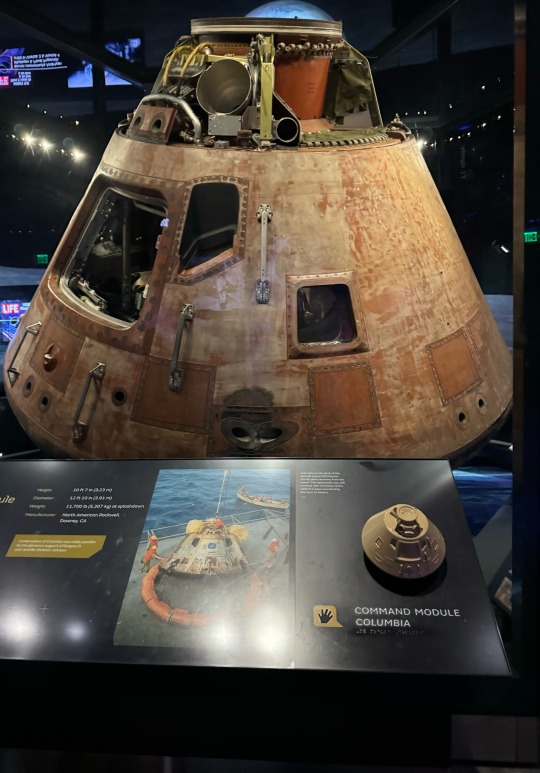
[Image Description: Photo of the Command Module Columbia exhibit at Smithsonian's National Air and Space Museum. The command module, which sits behind glass, is a full-size truncated cone with a docking probe and dish-shaped aft heat shield. In front of the glass is a sign with information about the command module on the left, a photograph in the middle, and a labeled smaller model on the right. The smaller model is labeled in both slightly raised text and Braille, and has a slightly raised hand icon next to it inside of a yellow speech bubble. End Image Description.]
This exhibit, like several others, included a part of the sign you were supposed to touch, as indicated by the hand symbol. This meant that people who couldn't see the actual thing behind the glass could get a very good idea of what every part of it looked like by touching the model and reading the label, which was offered in both raised letters and Braille.

[Image Description: Close up of the right side of the exhibit sign from the previous image. The light shining on the black surface of the exhibit sign shows darker spots where people left fingerprints. The entire Braille label is a near solid dark spot. End Image Description.]
This is obviously very cool and it's great that they invested inclusive design. But what really struck me about this was how much it was being used. You can tell from the photo that the Braille part of the sign has had many fingers on it, but I don't actually think all of those were from members of the target audience.
I could be wrong, of course, you can never really tell if someone is blind or low vision simply by looking at them. But I saw multiple children come up and run their hands over the smaller model mounted to the sign. At least one of them was running their fingers along the Braille too.
And it wasn't just children either. I saw at least one adult (other than myself) interacting with a similar model in another exhibit, one of a footprint on the moon. This one openly encouraged you to touch it rather than just implying permission like the one in this picture did. And that got me thinking: how many more adults would be doing the same thing the kids were if they weren't held back by this unspoken "oh, this feature is not for me" assumption? There are many haptic learners out there, after all.
If the people who design these museums realized the potential for a curb cut effect here, how many more exhibits would have these features?
And having full three-dimensional modules for people to touch weren't the only thing this museum offered either. You don't have to have all that to make the sign more user-friendly to those who have trouble seeing it.

[Image Description: A sign with a two-dimensional diagram of the Blériot XI aircraft. Each part of the illustration, including the person next to it for size, is slightly raised off the surface of the sign. All words on the diagram are labeled in both raised text and Braille. Beside the diagram is a slightly raised hand icon next to it inside of a yellow speech bubble. The labeled parts are the front, propeller, rudder, and elevator, most of which have arrows pointing to the respective parts of the illustration. End Image Description.]
You can make two-dimensional diagrams accessible too.
Finally, as an aside, the videos at the exhibits, the ones you could play on your own, all had open captions, and at least one had open audio descriptions as well.
28 notes
·
View notes
Text
I don’t have a problem guys I swear…

F/A-18 Blue Angel - US Air and Space Museum (2015)
Air Force One - US Air and Space Museum (2017)
P- 51 Mustang - EAA AirVenture (2018)
Remove Before Flight - EAA AirVenture (2018)
Apollo Spacecraft - US Air and Space Museum (2018)
B-25 Mitchell - EAA AirVenture (2018)
Lockheed P-38 Lightning - EAA AirVenture (2019)
Atlantis Shuttle - US Space & Rocket Center (2020?)
Remove Before Flight (RBF) C-5 - EAA AirVenture (2022)
Red Gulfstream RBF - Fall Career Fair (2022)
Blue Gulfstream RBF - Work (2023)
B-29 Superfortress RBF - EAA AirVenture (2023)
EAA RBF - EAA AirVenture (2023)
“I’d rather be flying” EAA Warbirds RBF - EAA AirVenture (2023)
B-17 Flying Fortress RBF - EAA AirVenture (2023)
Spinning Prop Plane - National Air Force Museum (2023)
#2023 was the year of the keychains#if anyone knows of a good way to display the metal ones without damaging them please let me know#this is what happens when you finally get a grown up job#number 1 on my list is a 1500 euro bomber jacket from the company who made the jackets for Masters of the Air#keychains#I like planes#aviation#if I see an airplane keychain I buy it#keychains are dying yall#the B-17 lives on my car key with one of the RBF#I’ll show yall my puzzles next :)
25 notes
·
View notes
Photo

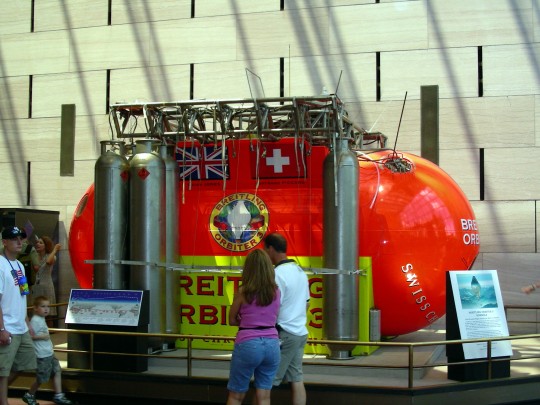

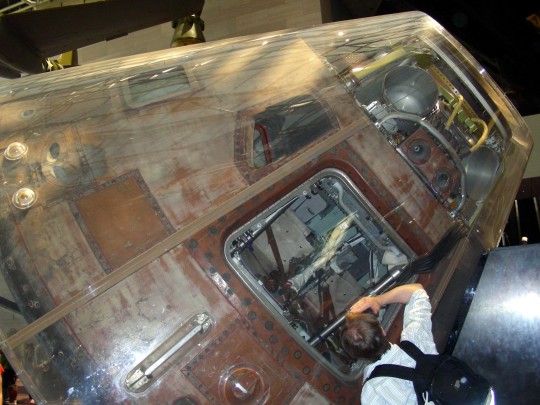
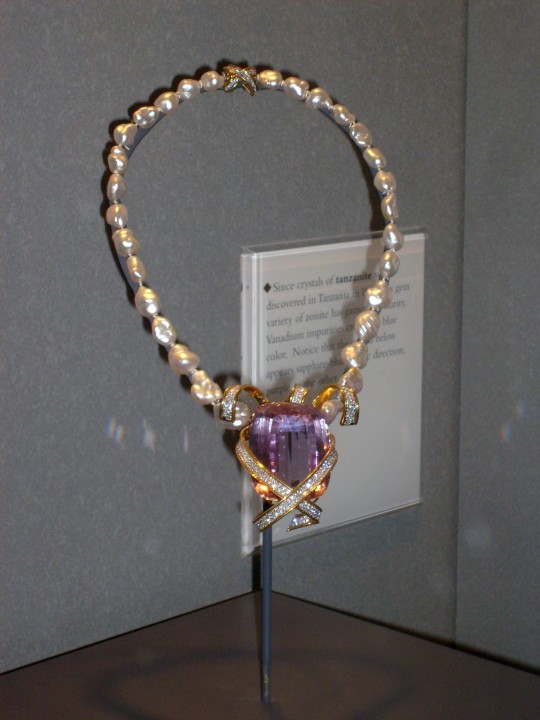

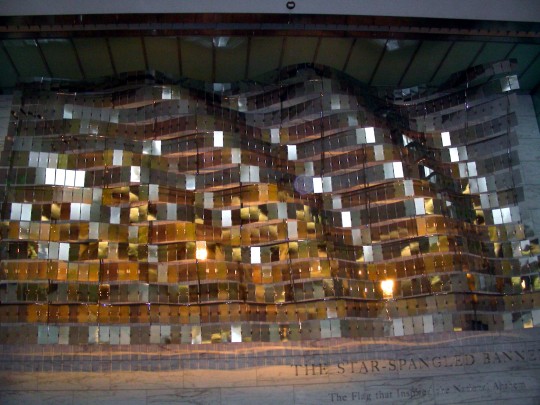



The Smithsonian Institution was chartered by the United States Congress after James Smithson donated $500,000 on August 10, 1846.
#Smithsonian National Zoological Park#Smithsonian National Air and Space Museum#National Museum of American History#National Museum of Natural History#USA#Washington DC#the Castle#the Mall#free admission#Breitling Orbiter 3 Gondola#Apollo 11 Command Module 'Columbia'#travel#Ryan NYP 'Spirit of St. Louis'#architecture#cityscape#Smithsonian Institution#10 August 1846#anniversary#US history#original photography#tourist attraction
13 notes
·
View notes
Text
Star Trek History...
Today, we (well, some of us) consider the USS ENTERPRISE from Star Trek a revered historic and cultural icon.
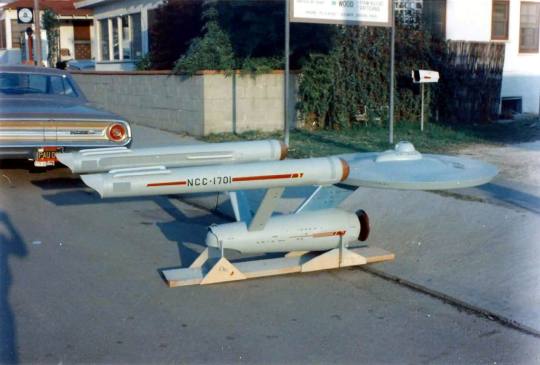
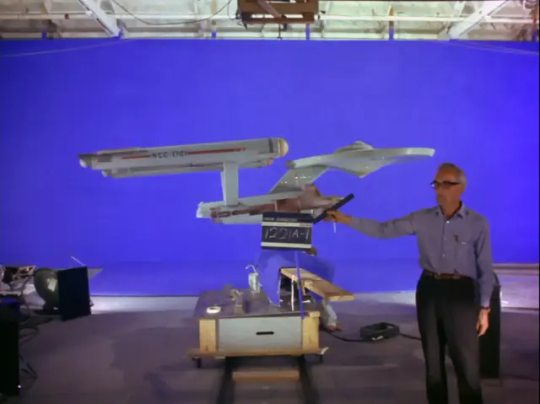
Back in the day tho... not so much.

Here, one of the warp engines leans casually against the wall in the Desilu art department. That's the ENTERPRISE designer Matt Jeffries. It was just a prop, a tool. The only value it had was to provide the on-screen representations for a weekly TV series.
After filming for the series wrapped, it was off to storage for the old starship...


... its condition slowly deteriorating over the years.

Finally in 1974 Paramount donated the filming model to the Smithsonian. After years on display and a couple of restorations/conservations...


...she now enjoys her comfortable retirement home in the National Air And Space Museum.
18 notes
·
View notes
Note
Hi Poppy! How was your trip? :D
Ooh, lots of fun! It was hub's and my 25th wedding anniversary trip, the first trip we've taken, just the two of us, since our honeymoon. It was my husband's first trip outside N. America (my second; we're so adventurous).
Edinburgh was lovely as always and I got to visit (twice!) my favourite painting of Achilles Lamenting the Death of Patroclus by Gavin Hamilton.

It's so much more beautiful in person, and I could talk about it all day. Just ask my Facebook friends, they'll tell you that's no lie.

"Enbra" was P A C K E D with tourists, shoulder to shoulder every damn where, but that's to be expected in summer. We took a day trip to Rosslyn Chapel (made famous in The Da Vinci Code, but that's not why we went), visited the National Gallery and the National Museum of Scotland (Dolly the cloned sheep is preserved there, and they have a very good Fashion gallery, including a few items by Alexander McQueen), and took a tour of a whisky distillery (with tasting!). I tried Irn Bru and Monster Munch, both for the first time. We went in Boots once, to get an emery board (my nails all decided to crack, peel, and become snaggly/scratchy for the duration of this trip, it was weird), and there was a DJ! Hilarious. Scottish people are lovely and kind, and no matter how fashionable/dressed up an Edinburgh woman is, she wears sensible shoes. I admire this immensely.

We spent a day in Melrose, Scotland, which is south of Edinburgh in what They call "the Borders" area of the UK. Melrose Abbey was impressive, we had lunch in a very British hotel restaurant (like the one in Fawlty Towers), and experienced how truly dog-mad Scotland is; we met about 60 local dogs and only about 40 local people. I swear you must get a dog with the key to yr flat, there. We also visited a small museum of Roman artifacts from the site of a nearby fort.

Spent one evening/overnight in Berwick-Upon-Tweed, the northernmost town in England--it was still light out at 10:15 when we left the restaurant where we ate dinner--which may be a name familiar to you if you are a fan of my fight!lock stories. Solely because it was a long journey by train from London, and sounded quaint, I sent John there to do some doctoring when he wasn't with Sherlock. Turns out it's the closest place to get a train to London, from Melrose.
London was London-y. We did all the things: the Tower of London, walked the south bank of the Thames, Big Ben/Parliament, stood at the fence of Buckingham Palace awaiting a guard change that never happened, Piccadilly Circus, Trafalgar Square, Borough Market, Camden Market/Camden High Street, V & A Museum, National Gallery.
A definite highlight was seeing Richard III performed by a fantastic all-female cast in Shakespeare's Globe theater. Absolutely recommend seeing Shakespeare at the Globe if you go to London; a completely unique experience.

The weather was H O T and if you ever needed proof that first world countries aren't coping quickly or well with climate change, just ride the London tube, or spend time in almost any indoor space in Britain. There is no air conditioning. It's no wonder heat waves have been killing Britons for the last few summers; the infrastructure is not set up to cope with the temperatures they're getting. We stood aside at one tube station to let cops and medics rush by us to attend to someone who had just been taken off a train and left on the platform (as signage instructs passengers to do) because of fainting from the heat.
There is no such thing as a cold drink in the UK! You can go into a shop and buy a can of Coke or sparkling water, and it is cool, but not cold. When servers heard our accents they would put two ice cubes in our glass at restaurants, but that's not enough. The only truly cold drinks I had there all ten days were gin & tonics, Aperol spritzes, and ciders. Alcohol comes iced; everything else--even the tap water!--just doesn't come cold. It was my only complaint.
Thanks for asking! Great to be home, of course, but it was a lovely ten days.

8 notes
·
View notes
Text


55 years ago… 1969, July 16
On launch day, Apollo 11 Lunar Module Pilot Edwin "Buzz" Aldrin wore his NASA-issued Omega Speedmaster NASA n° 43 on the lefthand wrist (Armstrong and Collins on the righthand wrist). Moonwalkers Armstrong & Aldrin wore Speedmaster 105.012-65 versions while Collins wore a Speedmaster 145.012-68.
The Apollo 11 "Eagle" stayed 21.5 hours on the Moon and the Moonwalkers performed a 2 hours 31 minutes long lunar EVA collecting 21 kilograms of lunar rocks & samples. Commander Neil Armstrong left his NASA n° 46 in the Lunar Lander as a backup time piece.
During the Apollo 11 lunar EVA, Aldrin wore the NASA n° 43 Speedmaster on the righthand wrist, afterwards not noticed by Omega marketing who added an extra watch at his lefthand wrist in the black & white advertising drawing.
During transfer to the NASM - National Air & Space Museum in Washington D.C., Aldrin's historic Omega Speedmaster got lost. For a moment it was rumoured it had stayed at the NASM after all and would be revealed for the 50th anniversary in July 2019. As this didn't happen, we have to assume that this famous Moonwatch has truly disappeared.
Anno 2024 only of the 12 are still with us; Edwin Aldrin (A11), David Scott (A15), Charles Duke (A16) and Harrison Schmitt (A17).
(Photos: NASA/Omega/EH Space Art/MoonwatchUniverse)
#astronaut#321#chronograph#Omega#Speedmaster#Moonwatch#MoonwatchUniverse#NASA#Apollo#Moon#Lune#Mond#Luna#spaceflight#Aldrin#1969#military#Zulu time
8 notes
·
View notes
Text

National Museum of the US Air Force, Dayton, OH
The National Museum of the U.S. Air Force, located near Dayton, Ohio, is the world's largest military aviation museum featuring more than 360 aerospace vehicles and missiles on display amid more than 19 acres of indoor exhibit space.
42 notes
·
View notes
